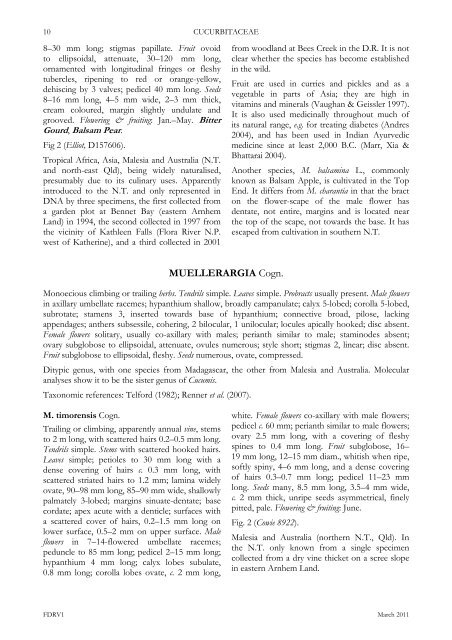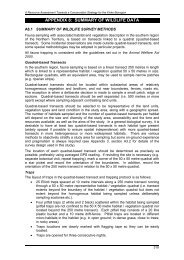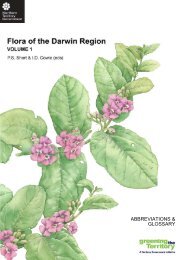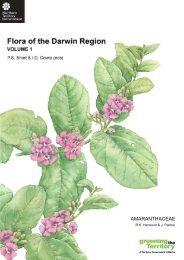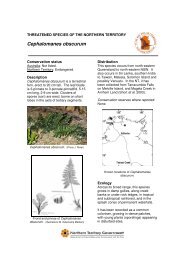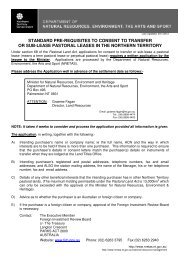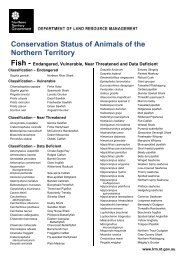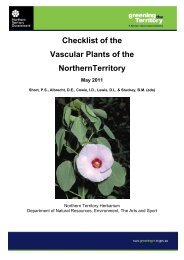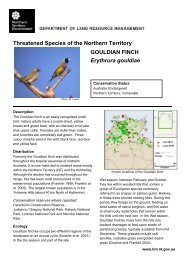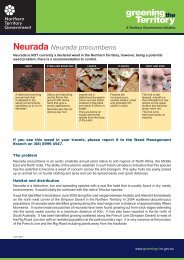CUCURBITACEAE - Department of Land Resource Management
CUCURBITACEAE - Department of Land Resource Management
CUCURBITACEAE - Department of Land Resource Management
Create successful ePaper yourself
Turn your PDF publications into a flip-book with our unique Google optimized e-Paper software.
10<br />
<strong>CUCURBITACEAE</strong><br />
8–30 mm long; stigmas papillate. Fruit ovoid from woodland at Bees Creek in the D.R. It is not<br />
to ellipsoidal, attenuate, 30–120 mm long, clear whether the species has become established<br />
ornamented with longitudinal fringes or fleshy in the wild.<br />
tubercles, ripening to red or orange-yellow,<br />
dehiscing by 3 valves; pedicel 40 mm long. Seeds<br />
8–16 mm long, 4–5 mm wide, 2–3 mm thick,<br />
cream coloured, margin slightly undulate and<br />
grooved. Flowering & fruiting: Jan.–May. Bitter<br />
Gourd, Balsam Pear.<br />
Fruit are used in curries and pickles and as a<br />
vegetable in parts <strong>of</strong> Asia; they are high in<br />
vitamins and minerals (Vaughan & Geissler 1997).<br />
It is also used medicinally throughout much <strong>of</strong><br />
its natural range, e.g. for treating diabetes (Andres<br />
2004), and has been used in Indian Ayurvedic<br />
Fig 2 (Elliot, D157606).<br />
medicine since at least 2,000 B.C. (Marr, Xia &<br />
Tropical Africa, Asia, Malesia and Australia (N.T.<br />
Bhattarai 2004).<br />
and north-east Qld), being widely naturalised, Another species, M. balsamina L., commonly<br />
presumably due to its culinary uses. Apparently known as Balsam Apple, is cultivated in the Top<br />
introduced to the N.T. and only represented in End. It differs from M. charantia in that the bract<br />
DNA by three specimens, the first collected from on the flower-scape <strong>of</strong> the male flower has<br />
a garden plot at Bennet Bay (eastern Arnhem dentate, not entire, margins and is located near<br />
<strong>Land</strong>) in 1994, the second collected in 1997 from the top <strong>of</strong> the scape, not towards the base. It has<br />
the vicinity <strong>of</strong> Kathleen Falls (Flora River N.P.<br />
west <strong>of</strong> Katherine), and a third collected in 2001<br />
escaped from cultivation in southern N.T.<br />
MUELLERARGIA Cogn.<br />
Monoecious climbing or trailing herbs. Tendrils simple. Leaves simple. Probracts usually present. Male flowers<br />
in axillary umbellate racemes; hypanthium shallow, broadly campanulate; calyx 5-lobed; corolla 5-lobed,<br />
subrotate; stamens 3, inserted towards base <strong>of</strong> hypanthium; connective broad, pilose, lacking<br />
appendages; anthers subsessile, cohering, 2 bilocular, 1 unilocular; locules apically hooked; disc absent.<br />
Female flowers solitary, usually co-axillary with males; perianth similar to male; staminodes absent;<br />
ovary subglobose to ellipsoidal, attenuate, ovules numerous; style short; stigmas 2, linear; disc absent.<br />
Fruit subglobose to ellipsoidal, fleshy. Seeds numerous, ovate, compressed.<br />
Ditypic genus, with one species from Madagascar, the other from Malesia and Australia. Molecular<br />
analyses show it to be the sister genus <strong>of</strong> Cucumis.<br />
Taxonomic references: Telford (1982); Renner et al. (2007).<br />
M. timorensis Cogn.<br />
Trailing or climbing, apparently annual vine, stems<br />
to 2 m long, with scattered hairs 0.2–0.5 mm long.<br />
Tendrils simple. Stems with scattered hooked hairs.<br />
Leaves simple; petioles to 30 mm long with a<br />
dense covering <strong>of</strong> hairs c. 0.3 mm long, with<br />
scattered striated hairs to 1.2 mm; lamina widely<br />
ovate, 90–98 mm long, 85–90 mm wide, shallowly<br />
palmately 3-lobed; margins sinuate-dentate; base<br />
cordate; apex acute with a denticle; surfaces with<br />
a scattered cover <strong>of</strong> hairs, 0.2–1.5 mm long on<br />
lower surface, 0.5–2 mm on upper surface. Male<br />
flowers in 7–14-flowered umbellate racemes;<br />
peduncle to 85 mm long; pedicel 2–15 mm long;<br />
hypanthium 4 mm long; calyx lobes subulate,<br />
0.8 mm long; corolla lobes ovate, c. 2 mm long,<br />
white. Female flowers co-axillary with male flowers;<br />
pedicel c. 60 mm; perianth similar to male flowers;<br />
ovary 2.5 mm long, with a covering <strong>of</strong> fleshy<br />
spines to 0.4 mm long. Fruit subglobose, 16–<br />
19 mm long, 12–15 mm diam., whitish when ripe,<br />
s<strong>of</strong>tly spiny, 4–6 mm long, and a dense covering<br />
<strong>of</strong> hairs 0.3–0.7 mm long; pedicel 11–23 mm<br />
long. Seeds many, 8.5 mm long, 3.5–4 mm wide,<br />
c. 2 mm thick, unripe seeds asymmetrical, finely<br />
pitted, pale. Flowering & fruiting: June.<br />
Fig. 2 (Cowie 8922).<br />
Malesia and Australia (northern N.T., Qld). In<br />
the N.T. only known from a single specimen<br />
collected from a dry vine thicket on a scree slope<br />
in eastern Arnhem <strong>Land</strong>.<br />
FDRV1 March 2011


